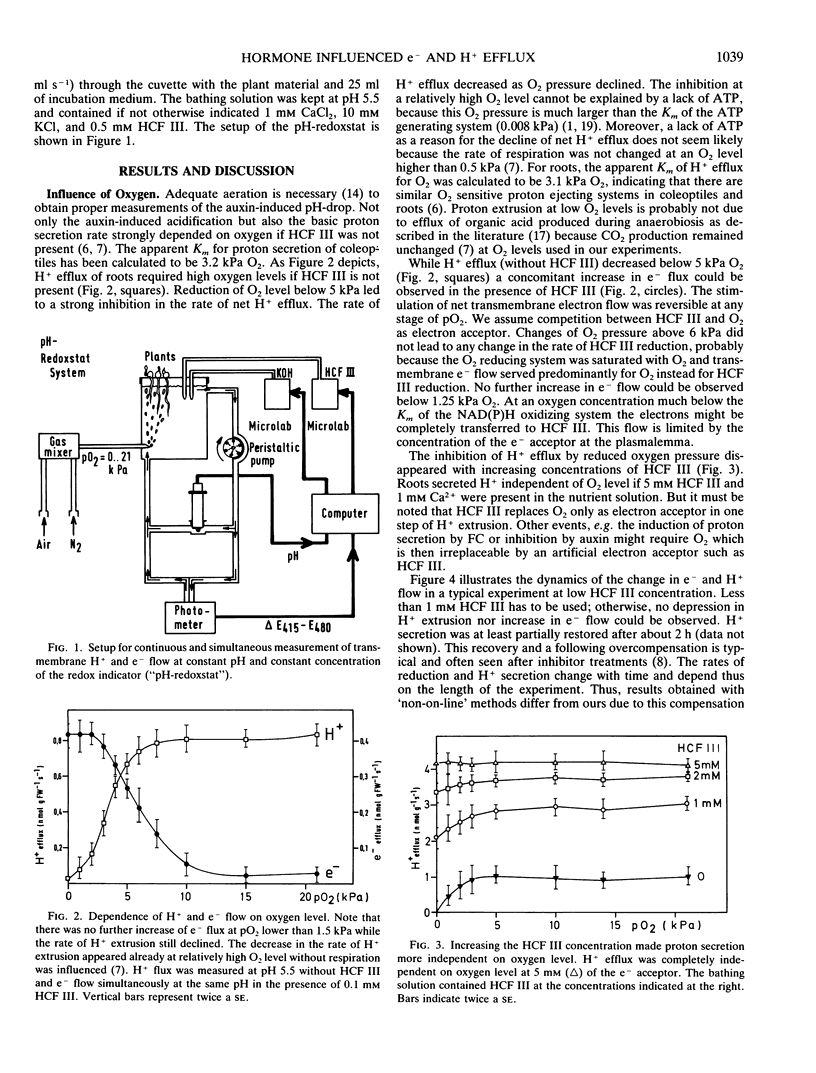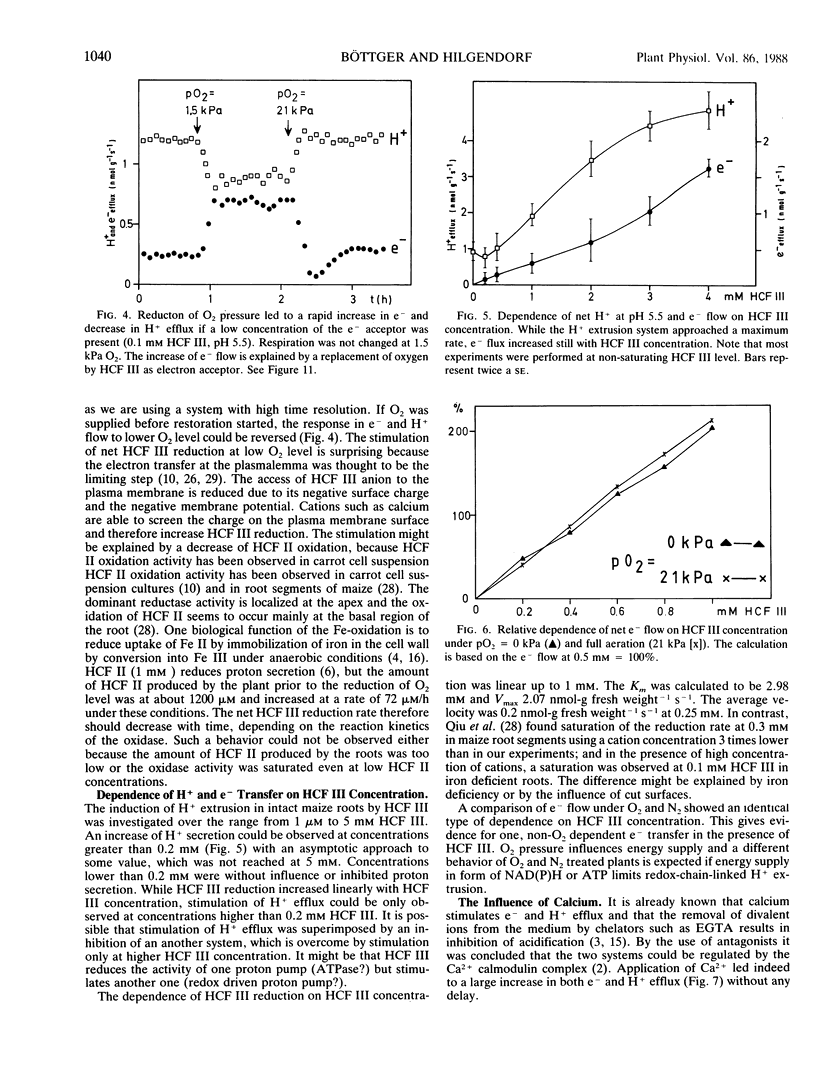Abstract
A possible involvement of two different systems in proton translocation was investigated by simultaneous measurement of transmembrane electron flow and proton secretion in a pH-stat combined with a redoxstat. The pH gradient between cytoplasm and apoplast is probably maintained by an H+ -pumping ATPase and by a second proton extrusion system, which seems to be linked to a redox chain with NAD(P)H as electron donor. Indole acetic acid inhibits both e− and H+ efflux, but only if the `electron draw' from the outside is not too high. The electron draw depends on the hexacyanoferrate level at the plasmalemma surface and on the Ca2+ concentration. The inhibiting effect of auxin on e− and H+ efflux in the presence of hexacyanoferrate can be only detected at low levels of bivalent cations and of the artificial electron acceptor. The inhibition of e− and H+ efflux by auxin requires high oxygen levels. The influence of auxin on both e− and H+ transfer disappears below 2 kilopascals O2, a level which does not influence respiration. Ethanol and fusicoccin do not increase the e− flux, probably because the electron transfer from the plasma membrane to HCF III is the limiting step. If electron transfer is reduced by IAA pretreatment, ethanol increases e− flux. Fusicoccin decreases e− and increases H+ efflux if the rates have been lowered previously by indole acetic acid pretreatment. This effect depends on high oxygen levels and is reversible by lowering oxygen pressure. Auxin and Ca2+ change e− flow and H+ ejection in a 1:1 ratio.
Full text
PDF





Selected References
These references are in PubMed. This may not be the complete list of references from this article.
- Barr R., Stone B., Craig T. A., Crane F. L. Evidence for Ca++-calmodulin control of transplasmalemma electron transport in carrot cells. Biochem Biophys Res Commun. 1985 Jan 16;126(1):262–268. doi: 10.1016/0006-291x(85)90600-x. [DOI] [PubMed] [Google Scholar]
- Bienfait H. F., van den Briel W., Mesland-Mul N. T. Free space iron pools in roots: generation and mobilization. Plant Physiol. 1985 Jul;78(3):596–600. doi: 10.1104/pp.78.3.596. [DOI] [PMC free article] [PubMed] [Google Scholar]
- Briskin D. P., Thornley W. R., Poole R. J. Vanadate-dependent NADH oxidation in microsomal membranes of sugar beet. Arch Biochem Biophys. 1985 Jan;236(1):228–237. doi: 10.1016/0003-9861(85)90622-8. [DOI] [PubMed] [Google Scholar]
- Crane F. L., Sun I. L., Clark M. G., Grebing C., Löw H. Transplasma-membrane redox systems in growth and development. Biochim Biophys Acta. 1985 Aug 1;811(3):233–264. doi: 10.1016/0304-4173(85)90013-8. [DOI] [PubMed] [Google Scholar]
- Evans M. L., Vesper M. J. An Improved Method for Detecting Auxin-induced Hydrogen Ion Efflux from Corn Coleoptile Segments. Plant Physiol. 1980 Oct;66(4):561–565. doi: 10.1104/pp.66.4.561. [DOI] [PMC free article] [PubMed] [Google Scholar]
- Federico R., Giartosio C. E. A transplasmamembrane electron transport system in maize roots. Plant Physiol. 1983 Sep;73(1):182–184. doi: 10.1104/pp.73.1.182. [DOI] [PMC free article] [PubMed] [Google Scholar]
- Lin W. Further Characterization on the Transport Property of Plasmalemma NADH Oxidation System in Isolated Corn Root Protoplasts. Plant Physiol. 1984 Feb;74(2):219–222. doi: 10.1104/pp.74.2.219. [DOI] [PMC free article] [PubMed] [Google Scholar]
- Lin W. Isolation of NADH Oxidation System from the Plasmalemma of Corn Root Protoplasts. Plant Physiol. 1982 Jul;70(1):326–328. doi: 10.1104/pp.70.1.326. [DOI] [PMC free article] [PubMed] [Google Scholar]
- Lüthen H., Böttger M. Hexachloroiridate IV as an Electron Acceptor for a Plasmalemma Redox System in Maize Roots. Plant Physiol. 1988 Apr;86(4):1044–1047. doi: 10.1104/pp.86.4.1044. [DOI] [PMC free article] [PubMed] [Google Scholar]
- Meyer T. E., Przysiecki C. T., Watkins J. A., Bhattacharyya A., Simondsen R. P., Cusanovich M. A., Tollin G. Correlation between rate constant for reduction and redox potential as a basis for systematic investigation of reaction mechanisms of electron transfer proteins. Proc Natl Acad Sci U S A. 1983 Nov;80(22):6740–6744. doi: 10.1073/pnas.80.22.6740. [DOI] [PMC free article] [PubMed] [Google Scholar]
- Rubinstein B., Stern A. I., Stout R. G. Redox activity at the surface of oat root cells. Plant Physiol. 1984 Oct;76(2):386–391. doi: 10.1104/pp.76.2.386. [DOI] [PMC free article] [PubMed] [Google Scholar]


